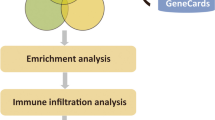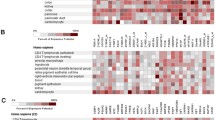Abstract
Keshan disease (KD) is an endemic cardiomyopathy with high mortality. Selenium (Se) deficiency is closely related to KD, while magnesium (Mg) plays many critical roles in the cardiovascular function. The molecular mechanism of KD pathogenesis is still unclear. Until now, we have not found any studies investigating the association between Se- or Mg-related genes and KD. In this study, oligonucleotide microarray analysis was used to identify the differentially expressed genes in the peripheral blood mononuclear cells between KD patients and normal controls. Next, human metabolome database (HMDB) was used to screen Se- and Mg-related genes. Function classification, gene pathway, and interaction network of Se- and Mg-related genes in KD peripheral blood mononuclear cells were defined by FunRich (functional enrichment analysis tool). Among 83 differentially expressed genes, five Se-related (DIO2, GPX1, GPX2, GPX4, and GPX7) and five Mg-related (ACSL6, EYA4, IDH2, PPM1A, and STK11) genes were recognized from HMDB. Two significant biological processes (energy pathways and metabolism), one molecular function (peroxidase activity), one biological pathway (glutathione redox reactions I), and one gene interaction network were constituted from Se-related and Mg-related genes. Se-related gene DIO2 and Mg-related genes STK11 and IDH2 may have key roles in the myocardial dysfunction of KD. However, we still have not obtained any interaction between Se-related gene and Mg-related gene. The interactions between RPS6KB1, PTEN, ATM, HSP90AA1, SNRK, PRKAA2, SMARCA4, HSPA1A, and STK11 may play important roles in the abnormal cardiac function of KD.

Similar content being viewed by others
References
Wang S, Lv Y, Wang Y, du P, Tan W, Lammi MJ, Guo X (2018) Network analysis of Se- and Zn-related proteins in the serum proteomics expression profile of the endemic dilated cardiomyopathy Keshan disease. Biol Trace Elem Res 183:40–48. https://doi.org/10.1007/s12011-017-1063-6
Tan J, Zhu W, Wang W et al (2002) Selenium in soil and endemic diseases in China. Sci Total Environ 284:227–235. https://doi.org/10.1016/S0048-9697(01)00889-0
He SL, Tan WH, Wang S, Wu C, Wang P, Wang B, Su X, Zhao J, Guo X, Xiang Y (2014) Genome-wide study reveals an important role of spontaneous autoimmunity, cardiomyocyte differentiation defect and antiangiogenic activities in gender-specific gene expression in Keshan disease. Chin Med J 127:72–78. https://doi.org/10.3760/cma.j.issn.0366-6999.20131167
Blankenberg S, Rupprecht HJ, Bickel C, Torzewski M, Hafner G, Tiret L, Smieja M, Cambien F, Meyer J, Lackner KJ, AtheroGene Investigators (2003) Glutathione peroxidase 1 activity and cardiovascular events in patients with coronary artery disease. N Engl J Med 349:1605–1613. https://doi.org/10.1056/NEJMoa030535
Chen J (1997) Trace elements and the etiology of Keshan disease. Foreign Med Sci (Section Medgeography) 18:47–48
Yan S (2008) Myocardial diseases and trace elements. Guangdong Trace Elem Sci 15:62
An R, Jiang X, Zhang G et al (1990) Study on the content of myocardial elements in Keshan disease. Natl Med J China 70:276–279
Wang S, Yan R, Wang B, du P, Tan W, Lammi MJ, Guo X (2018) Prediction of co-expression genes and integrative analysis of gene microarray and proteomics profile of Keshan disease. Sci Rep 8:231
Zhao Y, Li MC, Simon R (2005) An adaptive method for cDNA microarray normalization. BMC Bioinformatics 6:28
Wishart DS, Jewison T, Guo AC, Wilson M, Knox C, Liu Y, Djoumbou Y, Mandal R, Aziat F, Dong E, Bouatra S, Sinelnikov I, Arndt D, Xia J, Liu P, Yallou F, Bjorndahl T, Perez-Pineiro R, Eisner R, Allen F, Neveu V, Greiner R, Scalbert A (2013) HMDB 3.0—the human metabolome database in 2013. Nucleic Acids Res 41:D801–D807. https://doi.org/10.1093/nar/gks1065
Pathan M, Keerthikumar S, Ang CS, Gangoda L, Quek CYJ, Williamson NA, Mouradov D, Sieber OM, Simpson RJ, Salim A, Bacic A, Hill AF, Stroud DA, Ryan MT, Agbinya JI, Mariadason JM, Burgess AW, Mathivanan S (2015) FunRich: an open access standalone functional enrichment and interaction network analysis tool. Proteomics 15:2597–2601
Liu ZW, Zhu HT, Chen KL, Qiu C, Tang KF, Niu XL (2013) Selenium attenuates high glucose-induced ROS/TLR-4 involved apoptosis of rat cardiomyocyte. Biol Trace Elem Res 156:262–270. https://doi.org/10.1007/s12011-013-9857-7
Kolte D, Vijayaraghavan K, Khera S, Sica DA, Frishman WH (2014) Role of magnesium in cardiovascular diseases. Cardiol Rev 22:182–192. https://doi.org/10.1097/CRD.0000000000000003
Dentice M, Morisco C, Vitale M, Rossi G, Fenzi G, Salvatore D (2003) The different cardiac expression of the type 2 iodothyronine deiodinase gene between human and rat is related to the differential response of the dio 2 genes to Nkx-2.5 and GATA-4 transcription factors. Mol Endocrinol 17:1508–1521. https://doi.org/10.1210/me.2002-0348
Behunin SM, Lopez Pier MA, Birch CL et al (2015) LKB1/Mo25/STRAD uniquely impacts sarcomeric contractile function and posttranslational modification. Biophys J 108:1484–1494. https://doi.org/10.1016/j.bpj.2015.02.012
Kumar SD, Vijaya M, Samy RP, Dheen ST, Ren M, Watt F, Kang YJ, Bay BH, Tay SSW (2012) Zinc supplementation prevents cardiomyocyte apoptosis and congenital heart defects in embryos of diabetic mice. Free Radic Biol Med 53:1595–1606. https://doi.org/10.1016/j.freeradbiomed.2012.07.008
Jain M, Brenner DA, Cui L, Lim CC, Wang B, Pimentel DR, Koh S, Sawyer DB, Leopold JA, Handy DE, Loscalzo J, Apstein CS, Liao R (2003) Glucose-6-phosphate dehydrogenase modulates cytosolic redox status and contractile phenotype in adult cardiomyocytes. Circ Res 93:e9–e16. https://doi.org/10.1161/01.RES.0000083489.83704.76
Roe ND, Xu X, Kandadi MR, Hu N, Pang J, Weiser-Evans MCM, Ren J (2015) Targeted deletion of PTEN in cardiomyocytes renders cardiac contractile dysfunction through interruption of Pink1-AMPK signaling and autophagy. Biochim Biophys Acta Mol basis Dis 1852:290–298. https://doi.org/10.1016/j.bbadis.2014.09.002
Pang J, Fuller ND, Hu N, Barton LA, Henion JM, Guo R, Chen Y, Ren J (2016) Alcohol dehydrogenase protects against endoplasmic reticulum stress-induced myocardial contractile dysfunction via attenuation of oxidative stress and autophagy: role of PTEN-Akt-mTOR signaling. PLoS One 11:e0147322. https://doi.org/10.1371/journal.pone.0147322
Golubnitschaja O (2007) Cell cycle checkpoints: the role and evaluation for early diagnosis of senescence, cardiovascular, cancer, and neurodegenerative diseases. Amino Acids 32:359–371. https://doi.org/10.1007/s00726-006-0473-0
Zhou J, Li G, Wang ZH, Wang LP, Dong PJ (2013) Effects of low-dose hydroxychloroquine on expression of phosphorylated Akt and p53 proteins and cardiomyocyte apoptosis in peri-infarct myocardium in rats. Exp Clin Cardiol 18:e95–e98
Kato H, Takashima S, Asano Y, Shintani Y, Yamazaki S, Seguchi O, Yamamoto H, Nakano A, Higo S, Ogai A, Minamino T, Kitakaze M, Hori M (2008) Identification of p32 as a novel substrate for ATM in heart. Biochem Biophys Res Commun 366:885–891. https://doi.org/10.1016/j.bbrc.2007.11.175
Hammond EM, Dorie MJ, Giaccia AJ (2003) ATR/ATM targets are phosphorylated by ATR in response to hypoxia and ATM in response to reoxygenation. J Biol Chem 278:12207–12213. https://doi.org/10.1074/jbc.M212360200
Foster CR, Singh M, Subramanian V, Singh K (2011) Ataxia telangiectasia mutated kinase plays a protective role in β-adrenergic receptor-stimulated cardiac myocyte apoptosis and myocardial remodeling. Mol Cell Biochem 353:13–22. https://doi.org/10.1007/s11010-011-0769-6
Zhu WS, Guo W, Zhu JN, Tang CM, Fu YH, Lin QX, Tan N, Shan ZX (2016) Hsp90aa1: a novel target gene of miR-1 in cardiac ischemia/reperfusion injury. Sci Rep 6:24498. https://doi.org/10.1038/srep24498
Cossette SM, Bhute VJ, Bao X, Harmann LM, Horswill MA, Sinha I, Gastonguay A, Pooya S, Bordas M, Kumar SN, Mirza SP, Palecek SP, Strande JL, Ramchandran R (2016) Sucrose nonfermenting-related kinase enzyme-mediated rho-associated kinase signaling is responsible for cardiac function. Circ Cardiovasc Genet 9:474–486. https://doi.org/10.1161/CIRCGENETICS.116.001515
Liu Y, Zhang FB, Tang SH, Wang P, Li S, Su J, Zhou RR, Zhang JQ, Sun HF (2018) Analysis on “component-target-pathway” of Paeonia lactiflora in treating cardiac diseases based on data mining. Zhongguo Zhong Yao Za Zhi 43:1310–1316
Barry SP, Lawrence KM, McCormick J, Soond SM, Hubank M, Eaton S, Sivarajah A, Scarabelli TM, Knight RA, Thiemermann C, Latchman DS, Townsend PA, Stephanou A (2010) New targets of urocortin-mediated cardioprotection. J Mol Endocrinol 45:69–85. https://doi.org/10.1677/JME-09-0148
Liu XY, Liao HH, Feng H, Zhang N, Yang JJ, Li WJ, Chen S, Deng W, Tang QZ (2018) Icariside II attenuates cardiac remodeling via AMPKα2/mTORC1 in vivo and in vitro. J Pharmacol Sci 138:38–45. https://doi.org/10.1016/j.jphs.2018.08.010
Hang CT, Yang J, Han P, Cheng HL, Shang C, Ashley E, Zhou B, Chang CP (2010) Chromatin regulation by Brg1 underlies heart muscle development and disease. Nature 466:62–67. https://doi.org/10.1038/nature09130
Bultman SJ, Holley DW, G de Ridder G et al (2016) BRG1 and BRM SWI/SNF ATPases redundantly maintain cardiomyocyte homeostasis by regulating cardiomyocyte mitophagy and mitochondrial dynamics in vivo. Cardiovasc Pathol 25:258–269. https://doi.org/10.1016/j.carpath.2016.02.004
Gao S, Yang Z, Shi R, Xu D, Li H, Xia Z, Wu QP, Yao S, Wang T, Yuan S (2016) Diabetes blocks the cardioprotective effects of sevoflurane postconditioning by impairing Nrf2/Brg1/HO-1 signaling. Eur J Pharmacol 779:111–121. https://doi.org/10.1016/j.ejphar.2016.03.018
Kim YK, Suarez J, Hu Y, McDonough PM, Boer C, Dix DJ, Dillmann WH (2006) Deletion of the inducible 70-kDa heat shock protein genes in mice impairs cardiac contractile function and calcium handling associated with hypertrophy. Circulation 113:2589–2597. https://doi.org/10.1161/CIRCULATIONAHA.105.598409
Wang J, Wu ML, Cao SP, Cai H, Zhao ZM, Song YH (2018) Cycloastragenol ameliorates experimental heart damage in rats by promoting myocardial autophagy via inhibition of AKT1-RPS6KB1 signaling. Biomed Pharmacother 107:1074–1081. https://doi.org/10.1016/j.biopha.2018.08.016
Author information
Authors and Affiliations
Corresponding author
Ethics declarations
The subjects who had cardiovascular disease, hypertension, or diabetes were excluded from the study. Every subject involved in the investigation signed the informed consent. This investigation obtained the approval of Human Ethics Committee of Xi’an Jiaotong University, Xi’an, Shaanxi, China. We confirm that all the experiments were performed in accordance with the relevant guidelines and regulations.
Conflict of Interest
The authors declare that they have no conflict of interest.
Additional information
Publisher’s Note
Springer Nature remains neutral with regard to jurisdictional claims in published maps and institutional affiliations.
Rights and permissions
About this article
Cite this article
Wang, S., Yan, R., Wang, B. et al. The Functional Analysis of Selenium-Related Genes and Magnesium-Related Genes in the Gene Expression Profile Microarray in the Peripheral Blood Mononuclear Cells of Keshan Disease. Biol Trace Elem Res 192, 3–9 (2019). https://doi.org/10.1007/s12011-019-01750-2
Received:
Accepted:
Published:
Issue Date:
DOI: https://doi.org/10.1007/s12011-019-01750-2




